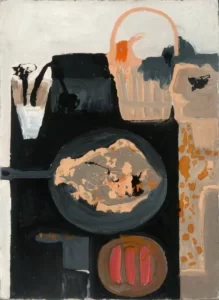Margaret Mellis (22 January 1914 – 17 March 2009) was a “pivotal” figure in modernist British art.[1] She was for a time a leading figure in the St Ives group of artists after she and her husband moved there in 1939,[2] but it was following her move to Suffolk with her second husband that she began to develop her own distinctive style.[3]
Margaret was born in Wukingfu (Wujingfu), Swatow, China, where her father was a Presbyterian missionary. Her family returned to their native Scotland shortly after the outbreak of the First World War in 1914,[4] so that her father could enlist.[3]
Growing up in Edinburgh, Margaret initially decided that she wanted to become a musician, until a family friend, having seen some of her paintings, suggested she should instead study art.[3] She studied at the Edinburgh College of Art (ECA) from 1929 until 1933, when she won a travelling scholarship and studied in Paris under Andre Lhoté before moving on to Spain and Italy. Margaret then returned to the ECA, where she had a Fellowship from 1935 until 1937.[2]
St Ives
Margaret met the art critic and painter Adrian Stokes in 1936, and following their marriage two years later she moved to live with him in London.[2] But to escape the widely anticipated bombing of the city following the collapse of the 1938 Munich appeasement of Hitler, the couple moved to Carbis Bay, near St Ives, in Cornwall. They were followed by other artists, including Ben Nicholson, Barbara Hepworth and Naum Gabo, forming the so-called St Ives group. They encouraged Margaret to produce small abstract compositions, “springboards to all her daring works of the future”.[1]
But things did not go well for Margaret’s relationship with her husband. He had expected her to play the role of a submissive housewife, and it was not long before his attentions shifted to Margaret’s 17-year-old sister Ann, who had come to live with them. The couple divorced in 1946,[1] and Adrian Stokes married Ann the following year.[5][a]Although the Deceased Wife’s Sister Marriage Act of 1907Act of Parliament making it legal for the first time in the United Kingdom for a man to marry his dead wife's sister. had legalised marriages between a widower and his deceased wife’s sister, the same was not true for the sisters of a divorced wife until the passage of the 1949 Marriage Act . So Ann and Adrian moved to Switzerland to bypass the British laws of consanguinity.[5]
Suffolk
Margaret married the painter Francis Davison, also recently divorced, in 1948. For two years they lived in the run-down Château des Enfants on the Cap d’Antibes,[1][4] before moving to a borrowed fisherman’s shack in Walberswick on the Suffolk coast in 1950, and then to a smallholding at Syleham, near Diss.[3] After twenty-five years of relative isolation and self-sufficiency, broken occasionally by visiting artist friends, they moved to Southwold in 1976, where Margaret began to create driftwood sculptures.[1][3]
Margaret died on 17 March 2009, survived by her son Telfer, three grandchildren and four great-grandchildren. In a 1992-profile broadcast on Anglia TV she revealed that she had never lost her first love of music:[1]
Gallery
Notes
| a | Although the Deceased Wife’s Sister Marriage Act of 1907Act of Parliament making it legal for the first time in the United Kingdom for a man to marry his dead wife's sister. had legalised marriages between a widower and his deceased wife’s sister, the same was not true for the sisters of a divorced wife until the passage of the 1949 Marriage Act . So Ann and Adrian moved to Switzerland to bypass the British laws of consanguinity.[5] |
|---|









